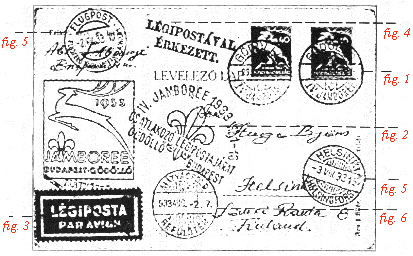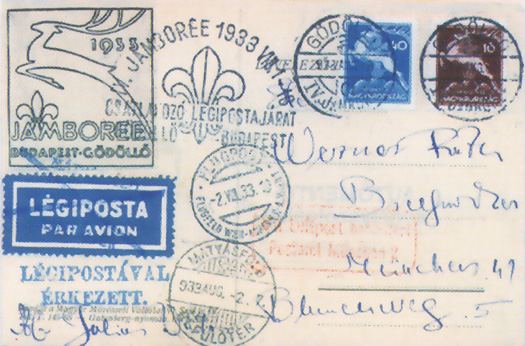Since the end of communism in Hungary, the market for all stamps, especially Scout items, has increased considerably. Philatelic material can be exported legally and since the introduction of auctions, the value of stamps have reached prices the Hungarian never thought possible. With low wages, the sales of good material has made some collectors wealthy. This has caused fake Scout material to appear on the market.
During 1994 a number of 1933 World Jamboree covers have been made and offered to dealers and collectors. Illustrated is one of these which is similar to at least twelve others seen in Europe and the United States. It would appear that forgeries have the letter "c" Gödöllő cancel, and show a "leaping stag" white label (taken from the United States Jamboree stationary cachet). The Jamboree cachet is normally in brown, but in the forgeries it is black.


GÖDÖLLŐ CANCEL (fig. 1) The letter "c" is not rounded like the original. All letters are thicker than the original steel cancel. In genuine the steel cancel impression generally comes through the cover. The letter "R" on the forgery has narrow legs against the wide ones on the original. The cancel is also blurred. All dated 2nd August, 1933.
SCOUT CACHET (fig. 2) Broken line in left side of fleur-de-lis. In the forgery the letter "T" in the word CSATLAKOZÓ has a blob on top. All letters are blurred.
AIR MAIL LABELS (fig. 3) The forger used a dark blue label, but labels from the Jamboree were much lighter, grey-blue in color.
LÉGIPOSTÁVAL ÉRKEZETT (fig. 4) The letters are blurred as are the acute accent lines over the "E" and "A". The top line of the last two letters "T" are thick when the original is very thin. The bottom of them are flat in the original but the fakes slope up and inward.
HELSINKI AND FLUGPOST CANCELS (fig. 5) Both cancels have blurred letters against the originals.
MÁTYÁSFÖLD CANCEL (fig. 6) The crown and letters are always blurred in the forgery.
Special Thanks to Fred Maarsen, R.S. Frank and
Douglas J. Uzakewicz for research assistance
SOSSI Journal, Volume 43, Number 7, September 1994


